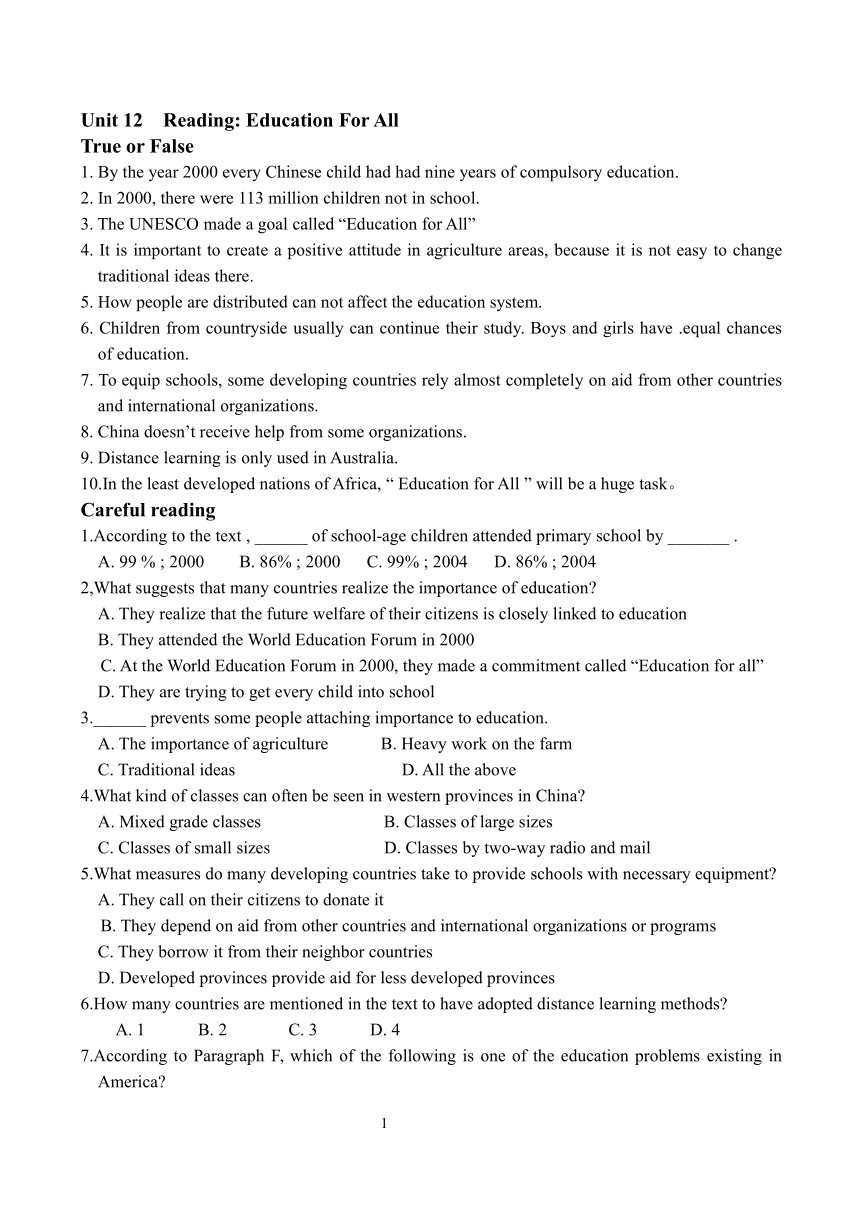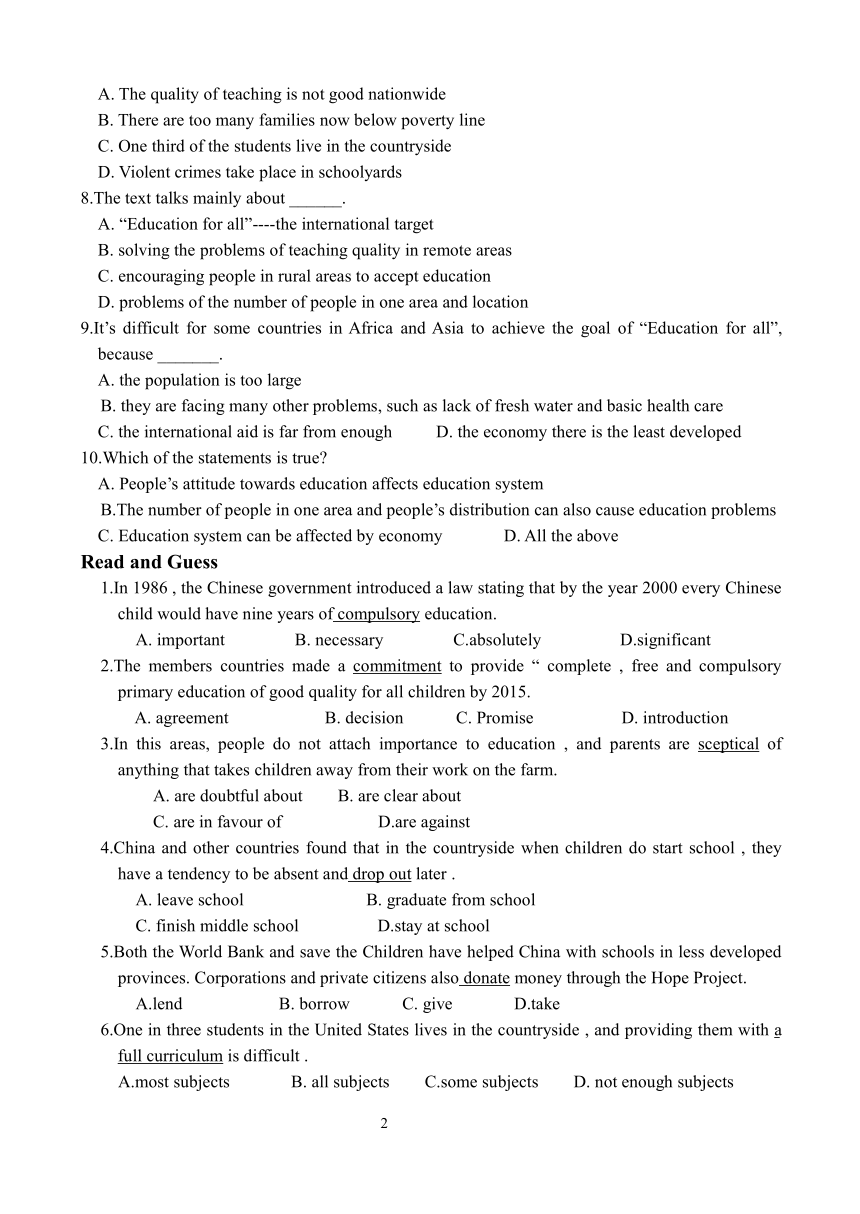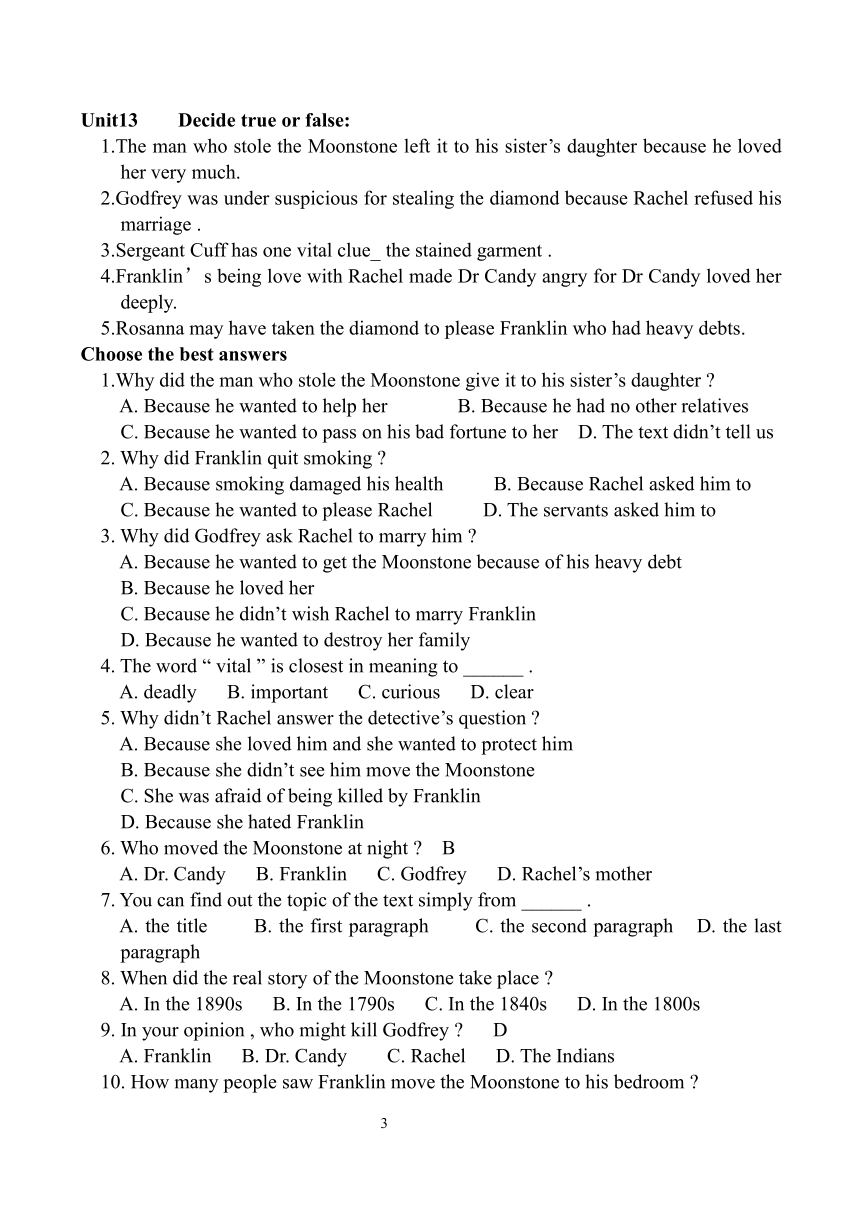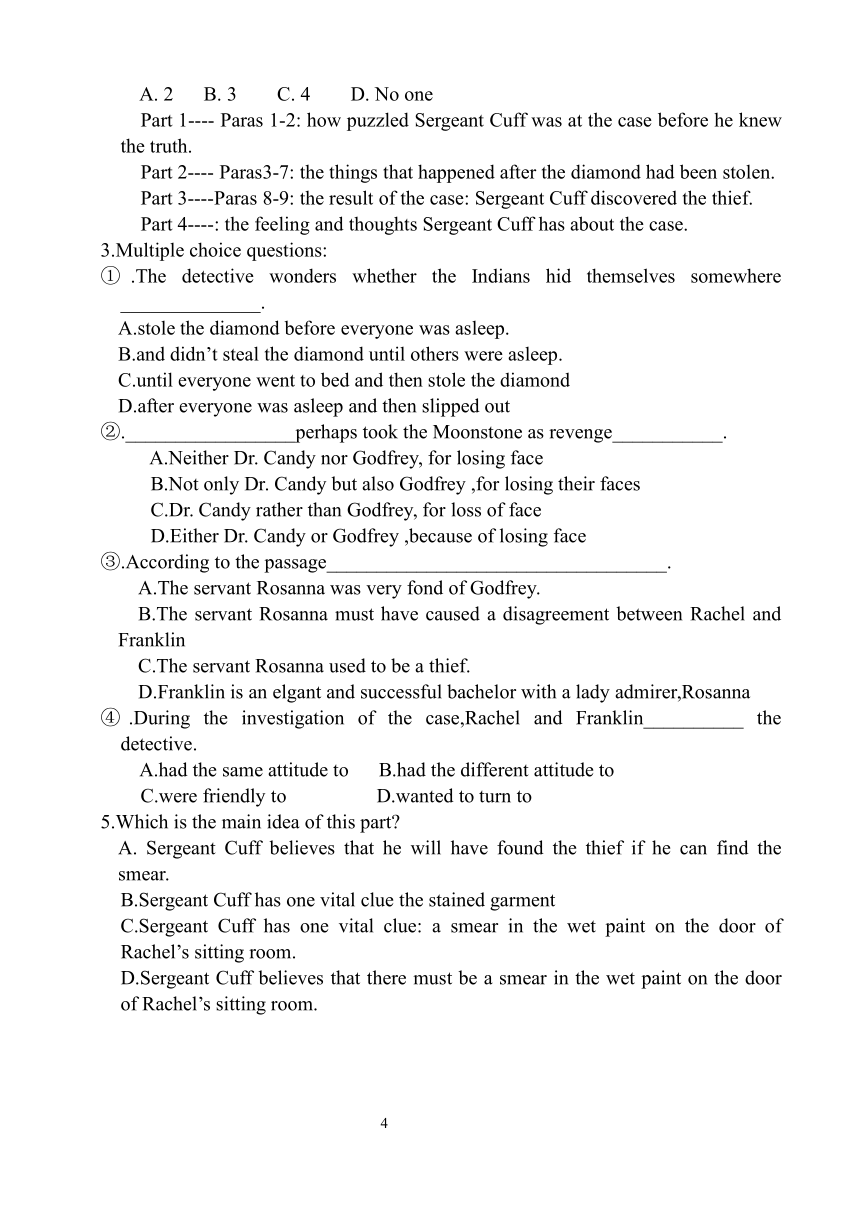高三第三册12-16单元课文理解题-新人教[下学期]
文档属性
| 名称 | 高三第三册12-16单元课文理解题-新人教[下学期] |  | |
| 格式 | rar | ||
| 文件大小 | 16.5KB | ||
| 资源类型 | 教案 | ||
| 版本资源 | |||
| 科目 | 英语 | ||
| 更新时间 | 2006-12-13 17:13:00 | ||
图片预览




文档简介
Unit 12 Reading: Education For All
True or False
1. By the year 2000 every Chinese child had had nine years of compulsory education.
2. In 2000, there were 113 million children not in school.
3. The UNESCO made a goal called “Education for All”
4. It is important to create a positive attitude in agriculture areas, because it is not easy to change traditional ideas there.
5. How people are distributed can not affect the education system.
6. Children from countryside usually can continue their study. Boys and girls have .equal chances of education.
7. To equip schools, some developing countries rely almost completely on aid from other countries and international organizations.
8. China doesn’t receive help from some organizations.
9. Distance learning is only used in Australia.
10.In the least developed nations of Africa, “ Education for All ” will be a huge task。
Careful reading
1.According to the text , ______ of school-age children attended primary school by _______ .
A. 99 % ; 2000 B. 86% ; 2000 C. 99% ; 2004 D. 86% ; 2004
2,What suggests that many countries realize the importance of education?
A. They realize that the future welfare of their citizens is closely linked to education
B. They attended the World Education Forum in 2000
C. At the World Education Forum in 2000, they made a commitment called “Education for all”
D. They are trying to get every child into school
3.______ prevents some people attaching importance to education.
A. The importance of agriculture B. Heavy work on the farm
C. Traditional ideas D. All the above
4.What kind of classes can often be seen in western provinces in China?
A. Mixed grade classes B. Classes of large sizes
C. Classes of small sizes D. Classes by two-way radio and mail
5.What measures do many developing countries take to provide schools with necessary equipment?
A. They call on their citizens to donate it
B. They depend on aid from other countries and international organizations or programs
C. They borrow it from their neighbor countries
D. Developed provinces provide aid for less developed provinces
6.How many countries are mentioned in the text to have adopted distance learning methods?
A. 1 B. 2 C. 3 D. 4
7.According to Paragraph F, which of the following is one of the education problems existing in America?
A. The quality of teaching is not good nationwide
B. There are too many families now below poverty line
C. One third of the students live in the countryside
D. Violent crimes take place in schoolyards
8.The text talks mainly about ______.
A. “Education for all”----the international target
B. solving the problems of teaching quality in remote areas
C. encouraging people in rural areas to accept education
D. problems of the number of people in one area and location
9.It’s difficult for some countries in Africa and Asia to achieve the goal of “Education for all”, because _______.
A. the population is too large
B. they are facing many other problems, such as lack of fresh water and basic health care
C. the international aid is far from enough D. the economy there is the least developed
10.Which of the statements is true?
A. People’s attitude towards education affects education system
B.The number of people in one area and people’s distribution can also cause education problems
C. Education system can be affected by economy D. All the above
Read and Guess
1.In 1986 , the Chinese government introduced a law stating that by the year 2000 every Chinese child would have nine years of compulsory education.
A. important B. necessary C.absolutely D.significant
2.The members countries made a commitment to provide “ complete , free and compulsory primary education of good quality for all children by 2015.
A. agreement B. decision C. Promise D. introduction
3.In this areas, people do not attach importance to education , and parents are sceptical of anything that takes children away from their work on the farm.
A. are doubtful about B. are clear about
C. are in favour of D.are against
4.China and other countries found that in the countryside when children do start school , they have a tendency to be absent and drop out later .
A. leave school B. graduate from school
C. finish middle school D.stay at school
5.Both the World Bank and save the Children have helped China with schools in less developed provinces. Corporations and private citizens also donate money through the Hope Project.
A.lend B. borrow C. give D.take
6.One in three students in the United States lives in the countryside , and providing them with a full curriculum is difficult .
A.most subjects B. all subjects C.some subjects D. not enough subjects
Unit13 Decide true or false:
1.The man who stole the Moonstone left it to his sister’s daughter because he loved her very much.
2.Godfrey was under suspicious for stealing the diamond because Rachel refused his marriage .
3.Sergeant Cuff has one vital clue_ the stained garment .
4.Franklin’s being love with Rachel made Dr Candy angry for Dr Candy loved her deeply.
5.Rosanna may have taken the diamond to please Franklin who had heavy debts.
Choose the best answers
1.Why did the man who stole the Moonstone give it to his sister’s daughter ?
A. Because he wanted to help her B. Because he had no other relatives
C. Because he wanted to pass on his bad fortune to her D. The text didn’t tell us
2. Why did Franklin quit smoking ?
A. Because smoking damaged his health B. Because Rachel asked him to
C. Because he wanted to please Rachel D. The servants asked him to
3. Why did Godfrey ask Rachel to marry him ?
A. Because he wanted to get the Moonstone because of his heavy debt
B. Because he loved her
C. Because he didn’t wish Rachel to marry Franklin
D. Because he wanted to destroy her family
4. The word “ vital ” is closest in meaning to ______ .
A. deadly B. important C. curious D. clear
5. Why didn’t Rachel answer the detective’s question ?
A. Because she loved him and she wanted to protect him
B. Because she didn’t see him move the Moonstone
C. She was afraid of being killed by Franklin
D. Because she hated Franklin
6. Who moved the Moonstone at night ? B
A. Dr. Candy B. Franklin C. Godfrey D. Rachel’s mother
7. You can find out the topic of the text simply from ______ .
A. the title B. the first paragraph C. the second paragraph D. the last paragraph
8. When did the real story of the Moonstone take place ?
A. In the 1890s B. In the 1790s C. In the 1840s D. In the 1800s
9. In your opinion , who might kill Godfrey ? D
A. Franklin B. Dr. Candy C. Rachel D. The Indians
10. How many people saw Franklin move the Moonstone to his bedroom ?
A. 2 B. 3 C. 4 D. No one
Part 1---- Paras 1-2: how puzzled Sergeant Cuff was at the case before he knew the truth.
Part 2---- Paras3-7: the things that happened after the diamond had been stolen.
Part 3----Paras 8-9: the result of the case: Sergeant Cuff discovered the thief.
Part 4----: the feeling and thoughts Sergeant Cuff has about the case.
3.Multiple choice questions:
①.The detective wonders whether the Indians hid themselves somewhere ______________.
A.stole the diamond before everyone was asleep.
B.and didn’t steal the diamond until others were asleep.
C.until everyone went to bed and then stole the diamond
D.after everyone was asleep and then slipped out
②._________________perhaps took the Moonstone as revenge___________.
A.Neither Dr. Candy nor Godfrey, for losing face
B.Not only Dr. Candy but also Godfrey ,for losing their faces
C.Dr. Candy rather than Godfrey, for loss of face
D.Either Dr. Candy or Godfrey ,because of losing face
③.According to the passage__________________________________.
A.The servant Rosanna was very fond of Godfrey.
B.The servant Rosanna must have caused a disagreement between Rachel and Franklin
C.The servant Rosanna used to be a thief.
D.Franklin is an elgant and successful bachelor with a lady admirer,Rosanna
④.During the investigation of the case,Rachel and Franklin__________ the detective.
A.had the same attitude to B.had the different attitude to
C.were friendly to D.wanted to turn to
5.Which is the main idea of this part?
A. Sergeant Cuff believes that he will have found the thief if he can find the smear.
B.Sergeant Cuff has one vital clue the stained garment
C.Sergeant Cuff has one vital clue: a smear in the wet paint on the door of Rachel’s sitting room.
D.Sergeant Cuff believes that there must be a smear in the wet paint on the door of Rachel’s sitting room.
Unit 14 Choose the best answers
1.The scientist can research the language of the honeybees because of the development of ____ . A. the modern beehive B. experiment C. dishes of honey D. both A and B
2. The phrase “ tell the bees apart ” in Paragraph 2 means ______ . A. tell the bees separately B. tell the difference of the bees
C. drive the bees away D. tear the bees into pieces
3. After the marked bees danced , the other bees _____ . A. danced together B. became very excited C. seemed not to noticed it D. both A and B
4. Different dances indict different ______ .
A. food B. feeding place C. steps D. semicircle
5. The phrase “ come to light ” in Paragraph 5 means _______ . A. become known B. come to a bright place C. turn bright D. both A and B
6. The circle dances told the bees about ______ . A. the position of the feeding place B. the distance of the feeding place C. the amount of the food D. all the information about food
7. The number of the wagging dances per minute told ______ . A. the position of the feeding place B. the amount of the food C. the distance of the feeding place D. all the information about food
8.You can find the main idea of the test simply from _____ . A. the title B. the first paragraph C. the second paragraph D. the last paragraph
9.Karl Von Frisch made an experiment to research ____ .
A. the food of honeybees B. the dance of honeybees C. the ways honeybees communicate D. the hive of honeybees
10. Which of the statements is possible according to the last paragraph? A. We human beings can communicate as honeybees do B. We human beings can go as quickly as honeybees C. We human beings can come to help each other in a fast way D. We human beings can learn something from animal’s behavior
11.Prof.von Frisch , conducting the bee experiment in the reading text, is known as a(n) ______.
A. detective B. zoologist C. astronomer D. biologist
12.The writing style of this text is _________.
A. subjective B. objective C. critical D. contradictory
true or false:
1.Scientists have interest in honey-bees because of the “language” they use to communicate with each other.
2.Professor Karl von Frisch built special hives and a transparent wall to observe bees.
3.After seeing one bee’s dance, the surrounding bees leave the hive and go to the feeding place directly.
4.The bees from close feeding place perform a wagging dance.
5.With a stop-watch, zoologists counted the time bees used to fly from the feeding place to the hive.
6. The expression “to make a beeline for someone or something” means to go quickly along a straight course for someone or something.
7. Professor von Frisch did so much work on the communication of the animals that he was awarded a Noble Prize in 1973.
Choose the best answers
1.According to the author, animals can be divided into _____.
A.higher primates and lower primates
B.new world primates and old world primates
C.animals and human beings
D.primates and other animals
2. In the passage, primates are defined as animals that _____.
A. have opposable thumbs and toes.
B. have a highly developed sense of touch.
C. have a larger brain
D. All of the above.
3.Which of the following is Not right?
A. Apes feast on almost the similar food to our humans.
B.Compared to monkeys, apes have fewer children.
C.Primates all live in groups
D.Chimpanzees can communicate with each other.
4. In what ways are the higher primates, for example chimpanzees, similar to human beings? Which is wrong?
A.Males are usually larger than females.
B.They use the same senses.
C.They have very long arms.
D.They have similar feet and hands.
5. The similarities between chimpanzees and human beings shows that ___.
A.They are able to do what humans do.
B.They can solve problems .
C.They can use human language.
D.They can use tools more often.
Unit15 Fast reading
1. Volunteers refer to _______ .
A.people who are willing to help others B.people who devote their time to helping others
C.people who donate their time to help others D.all of the above
2. Volunteer do voluntary work in order to _____.
A.make money B.make a contribution to society
C. kill time D.become healthy
3.________ vo1unteers are mentioned in the text. A.One B.Two C.Three D.Four
4. Volunteers are________
A. those who donate money to the poor B. those who donate their time to help others
C. those who work as teachers in a remote village
D. those who help old people with their daily life
5. The following people are volunteers except______.
A. Kofi Annan B. Lu Hao C. Lin Ying D. Meng Yu
6. How does the volunteer work help Lin Ying?
A. She has improved her weakest subject history. B. She has made many good friends.
C. Her work is making a big difference to the children's future.
D. She has acquired valuable skills and experience for her own career.
7. Meng Yu took part in an event to help starving children. Did she get any benefit herself at last?
A. Yes. She received money donations. B. No. She nearly died of starvation.
C. Yes. She made new friends and felt more positive.
D. No. She used to feel lonely and homesick at times.
8. According to the text, any voluntary work can benefit______.
A. those poor people B. those hungry children
C. the volunteers D.both the volunteers and the people they are helping.
9. The text mainly tells us _______.
A.vo1untary work is interesting B.vo1untary work is demanding
C.vo1untary work call make a difference not only to the helped people
but also to the vo1unteers themselves whatever kind it is
D. how to do vo1untary work
10. From the text we can infer that voluntary work is worth doing for______.
A. only young people B.healthy people
C. people with knowledge D. almost a11 people
11. All the following statements are true except ___
A. Mr Zhao couldn’t move about in that he suffered from poor eyesight.
B. Lin Ying joined the Go West Project organized by the Communist Youth league of China as a result of finding a job.
C. Meng Yu hasn’t received her master’s degree in Canada at the time of the text being described.
D. The volunteers became confident and mature, enriching their lives by helping others.
12. “The people here are poor, but they have big hearts…” The underlined part means____.
A. their hearts are big. B. they are broad-minded.
C. their hearts are beating faster
Unit16
True or False:
1. It was in 1992 that David’s career took off.
2. Employers need to advertise for football players in the newspapers or on the Internet when they have a vacant job.
3. Every footballer needs to have good team spirit,a strong character, mental strength and a positive attitude.
4. The players under sixteen have to take part in club training sessions all days long.
5. Youth trainees in UK football club usually have high salary.
6. When the trainees are offered a contract with a club, their life as a professional footballer begins.
7. Many of the players can only play as amateur footballers in their spare time.
Comprehension of Reading
1. Which of the following is true?
Little David disliked football because he was crazy.
David Beckham is famous as a front-field player.
David became known when he was in middle school.
David always wears the red No. 7 shirt.
2. You are very fond of football or basket-ball. Can you become a star in the future according to the text?
Certainly not B. Yes C. No D. Not sure.
3. How does a club find a talented player?
By advertisement B. By watching matches
From another club D. From middle school
4. What does the passage mainly tell us?
We must have some particular qualities when we are young.
We should be trained from childhood if we want to succeed.
We should have a suitable attitude to our career or amateur choice.
Born talent leads to success.
Unit12
1-10 FTTTF FTFFT
1-5 CCDAB 6-10 CCADD
1-6 BCAACB
UNIT13
1-5 FFTFF
1-10 CBABA BABDA 1-5 BDCBC
UNIT 14
1-12 DBDBA ACACD BB
1-7 TTFFFTT
UNIT 15
1-12 DBCBA DCDCD BB
UNIT 16
(TFTFFTF) (DDBC)
